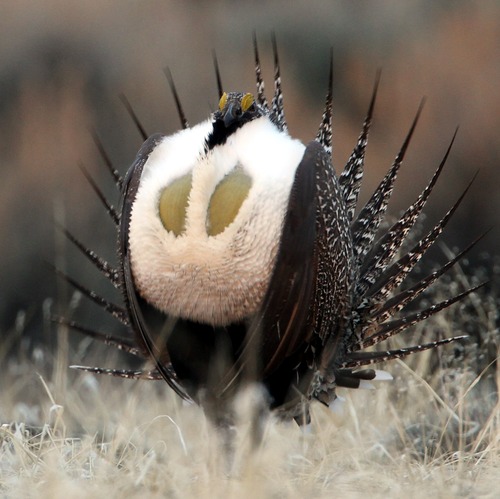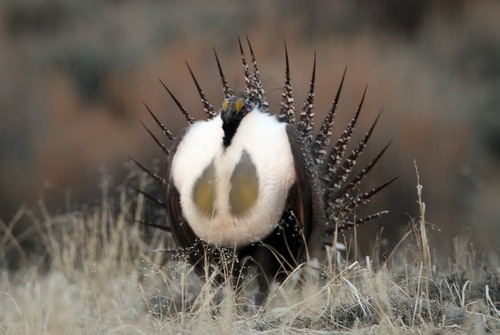This is an archived article that was published on sltrib.com in 2014, and information in the article may be outdated. It is provided only for personal research purposes and may not be reprinted.
A federal decision whether to list greater sage grouse as a protected species is at least 18 months away, but some Utah lawmakers are angling for $2 million in state money to crank up a lobbying campaign to get the federal government to delay listing for 10 years.
This request comes on top of another $1 million the state Public Lands Policy Coordination Office is seeking to gather data and construct legal arguments, anticipating "inevitable" litigation when the U.S. Fish and Wildlife Service decides whether to apply federal protections to the West's iconic bird. And another $200,000 is sought to help sage grouse efforts by state trust lands officials.
Such spending was quickly panned by Utah's conservation community, which believes the money would be far better spent on protecting and enhancing what's left of Utah's sage grouse habitat.
"We are going to spend $3 million on this fight that hasn't begun yet because the science has not been developed; it seem like overkill," advocate Steve Erickson said. "If you don't like the results of the science you resort to politics."
The Natural Resources, Agricultural and Environmental Quality Appropriations Subcommittee on Thursday endorsed the $2 million request along with about 40 others proposed by committee members. These requests, which would tap non-General Fund sources, include carp removal from Utah Lake, reseeding areas torched in recent wildfires and repairing flood damage to the Ogden Bay Waterfowl Management Area.
Topping priority lists of requests that tap the General Fund are $1.4 million for air quality research and money to support initiatives aimed at cleaning up Utah's air pollution.
The sage grouse money would be spent on outside consultants selected by the Department of Natural Resources, according to Rep. Mike Noel, R-Kanab, who requested the appropriation. The contractor would develop legal strategies, "educate" members of Congress and conduct public outreach, according to legislative intent language from Noel.
If this arrangement sounds familiar, it is. Past sessions have approved $300,000 appropriations to hire Big Game Forever, a Utah-based anti-wolf advocacy group, to lobby in support of state control of wolf management. No one is proposing to renew that controversial appropriation this session, even though the wolf delisting battle is still raging.
While the protected wolf is reviled by many ranchers and hunters, the sage grouse is a beloved inhabitant of the West's sagebrush prairies and remains a long way from being listed. And Utah's political leadership hopes to keep it that way, citing a $20 billion to $40 billion hit to the oil and gas industry should the feds decide the bird warrants protection across its range in 11 Western states.
More than half of Utah's leks, the sensitive areas sage grouse use for mating rituals, are on private and state trust lands, according to Rep. John Mathis, R-Vernal.
"The private citizens and schools will bear the brunt of the burden if it is listed as endangered," Mathis said. "Pray to God that it never gets listed."
Noel alleged outside groups are pouring "a ton of money" into campaigns to list sage grouse "for reasons that are not tied to preservation of the bird, but to keep people off the land."
The U.S. Fish and Wildlife Service is under a court order to make a listing decision by September 2015.
Sen. Jim Dabakis, D-Salt Lake City, said spending state money to influence this process "is very premature and we ought not to do it."
He proposed dedicating half the $2 million Noel seeks for lobbying to conservation measures, but the committee rejected that idea.
Utah and several other Western states have assembled grouse conservation plans with the goal of keeping the bird's management in state hands. But the feds have already signalled that plans for Utah, Montana, Nevada and Wyoming are not adequate for keeping sage grouse off the endangered or threatened lists, according to Sen. Kevin Van Tassell, R-Vernal.
The senator, who represents a booming oil and gas region, wants Fish and Wildlife to give the states ample time to see if their conservation plans work.
He claimed the bird's numbers are rebounding, proof that state control is effective, but critics say the Utah sage grouse plan will not save the bird because it allows too much development in sage grouse habitat and near leks, especially in the Uinta Basin, Van Tassell's district.
Ecologist Jim Catlin, founder of the Utah Wild Project, says numbers of grouse, which serves as "a canary in the coal mine" for landscape health in general, are dropping.
"The habitat degradation that has driven sage-grouse populations to decline is a west-wide problem that negatively impacts almost all wildlife and the productivity of the land," Catlin wrote in an e-mail. "Most of Utah's sage grouse habitat today is degraded, missing much of the key native grass cover needed for brood protection and insects."





